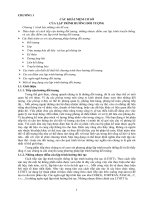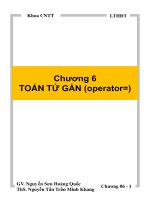Quá tải toán tử của lập trình hướng đối tượng
Bạn đang xem bản rút gọn của tài liệu. Xem và tải ngay bản đầy đủ của tài liệu tại đây (471.39 KB, 41 trang )
Chương 2
QUÁ TẢI TOÁN TỬ
1
Tài liệu đọc
Eckel Bruce, Thinking in C++ 2
rd
edition
12. Operator Overloading
Dietel, C++ How to Program 4
th
edition
Chapter 8 - Operator Overloading
2
Những nội dung chính
Giới thiệu
Các toán tử được phép và không
được phép quá tải (C++)
Hạn chế của quá tải toán tử
Cú pháp quá tải toán tử
Cài đặt quá tải toán tử
Các ví dụ
3
Giới thiệu
Các toán tử cho phép ta sử dụng cú pháp
toán học đối với các kiểu dữ liệu của C++
thay vì gọi hàm (nhưng bản chất vẫn là
gọi hàm)
Ví dụ thay a=set(b.add(c)) bằng a=b+c
Tự nhiên hơn
Đơn giản mã hóa chương trình
Quá tải toán tử: một toán tử có thể dùng
cho nhiều kiểu dữ liệu
4
Giải thích thêm
The interface for your class would likely be:
class MyString
{
private:
char string[ MAX_STRING ];
public:
MyString();
MyString( const char* );
const char* getString();
MyString& setString( const char* );
MyString& appendString( const char* );
bool isEqualTo( const char* );
};
5
Giải thích thêm (tt)
You could then write code like:
void main()
{
MyString string1( "Hello" );
MyString string2( "Good bye" );
MyString string3;
string3.setString( string1.getString() );
string3.appendString(" and ").appendString(string2.getString() );
if ( string1.isEqualTo( string2.getString() ) )
{
cout << "string1 == string2" << endl;
}
cout << string3.getString() << endl;
}
6
Giải thích thêm (tt)
That is good, but wouldn’t it be better if you could instead write code like:
void main()
{
MyString string1( "Hello" );
MyString string2( "Good bye" );
MyString string3;
string3 = string1;
string3 += " and ";
string3 += string2;
if ( string1 == string2 )
{
cout << "string1 == string2" << endl;
}
cout << string3 << endl;
}
7
8
Các tóan tử của C++ (tt)
9
Các toán tử quá tải được và
không quá tải được
Operators that can be overloaded
+ - * / % ^ & |
~ ! = < > += -= *=
/= %= ^= &= |= << >> >>=
<<= == != <= >= && || ++
->* , -> [] () new delete
new[] delete[]
Operators that can not be overloaded
. .* :: ?:
10
11
12
Cú pháp quá tải toán tử
Syntax is:
return_type
operator@(argument-list)
operator is a function
@ is one of C++ operator symbols (+, -, =, etc )
Examples:
operator+
operator-
operator*
operator/
13
Cài đặt các toán tử được quá tải
Có 3 cách cài đặt toán tử được quá
tải
Hàm thành viên (phương thức)
Hàm không thành viên toàn cục
Hàm bạn
Lựa chọn cách cài đặt phụ thuộc vào
Số toán hạng tham gia vào toán tử
Tính đóng gói
14
Cài đặt các toán tử được quá tải (tt)
Expression
obj1@obj2
translates into
a function call
obj1.operator@(obj2), if this function is
defined within class obj1
operator@(obj1,obj2), if this function is
defined outside the class obj1
15
Cài đặt bằng hàm thành viên
class Complex {
public:
Complex operator +(const Complex &op)
{
double real = _real + op._real,
imag = _imag + op._imag;
return(Complex(real, imag));
}
};
c = a+b;
c = a.operator+ (b);
16
Cài đặt bằng hàm không thành viên
class Complex {
public:
double real() { return _real; }
//need access functions
double imag() { return _imag; }
};
Complex operator +(Complex &op1, Complex &op2)
{
double real = op1.real() + op2.real(),
imag = op1.imag() + op2.imag();
return(Complex(real, imag));
}
c = a+b;
c = operator+ (a, b);
17
Cài đặt bằng hàm bạn
class Complex {
public:
friend Complex operator +(
const Complex &,
const Complex &
);
};
Complex operator +(Complex &op1, Complex &op2)
{
double real = op1._real + op2._real,
imag = op1._imag + op2._imag;
return(Complex(real, imag));
}
c = a+b;
c = operator+ (a, b);
18
Khi nào dùng hàm thành viên ?
When overloading ( ), [ ], ->, or =, the operator
overloading function must be declared as a class
member.
When an operator function is implemented as a
member function, the left most (or only in the
case of unary operators) operand must be a class
object (or a reference to a class object) of
operator's class
If member function, then
this
is implicitly
available for one of the arguments
19
Khi nào dùng hàm không
thành viên toàn cục ?
If the operator needs to be commutative
(a + b = b + a), then making it a non-
member function is necessary.
If the left operand must be an object of a
different class or a built-in type, this
operator must be implemented as a non-
class member. eg. <<, >> operators
20
Khi nào dùng hàm bạn ?
An operator function implemented as a non-
member must be a friend if it needs to access
non-public data members of that class.
The overloaded
<<
operator must have a left
operand of type
ostream
. Therefore, it must be a
non-member function. Also, it may require
access to the private data members of the class.
Thus, it needs to be a friend function for that
class.
Similar observation holds for
>>
operator which
has a left operand of type
istream
.
21
22
23
24
Ví dụ: Toán tử một ngôi (hàm
thành viên)
int main()
{
int i=2,j = 3,k;
i = j + k;
Complex C1(1,2), C2(4,5),
C3;
C3 = - C1;
C3.show();
return 0;
}
class Complex
{
int r, i;
public:
Complex operator-() {
Complex temp;
temp.r = -r ;
temp.i = -i ;
return temp; }
void show()
{cout<<r<<“+”<<i<<“i”};
};
25









